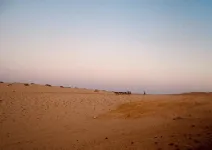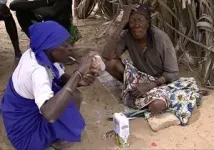Probing the deep genetic structure of Africa
DNA research from human populations thought to be uncontactable or extinct helps probe the deep genetic structure of Africa
2023-09-22
(Press-News.org)
Africa is the birthplace of modern humans and the continent with the highest level of genetic diversity. While ancient DNA studies are revealing some aspects of the genetic structure of Africa before the spread of food production, issues concerning DNA preservation have limited the insights from ancient DNA. Hoping to find clues in modern populations, researchers from a Portuguese-Angolan TwinLab ventured into the Angolan Namib desert – a remote, multi-ethnic region where different traditions met. “We were able to locate groups which were thought to have disappeared more than 50 years ago”, states Jorge Rocha, a population geneticist from Centro de Investigação em Biodiversidade e Recursos Genéticos (CIBIO, University of Porto) who led the fieldwork, together with Angolan anthropologists Samuel and Teresa Aço from the Centro de Estudos do Deserto (CEDO).
Among the communities the team encountered are the Kwepe, a pastoral group who used to speak a language known as Kwadi. “Kwadi was a click-language that shared a common ancestor with the Khoe languages spoken by foragers and herders across southern Africa,” explains Anne-Maria Fehn, a linguist from CIBIO who participated in the fieldwork and was able to interview what may well be the last two speakers of Kwadi. “Khoe-Kwadi languages have been linked to a prehistoric migration of eastern African pastoralists”, adds Rocha, whose research focuses on southern African population history. In addition, the team contacted Bantu-speaking groups that are part of the dominant pastoral tradition of southwest Africa, as well as marginalized groups whose origins have been associated with a foraging tradition, distinct from that of the neighboring Kalahari peoples, and whose original language was supposedly lost.
Modern DNA research can complement ancient DNA studies
The team‘s new study shows that the inhabitants of the Angolan Namib are quite divergent from other modern populations but also highly structured among themselves. “In agreement with our previous studies on the maternally-inherited DNA, most genome-wide diversity segregates according to socio-economic status. A lot of our efforts were placed in understanding how much of this local variation and global excentricity was caused by genetic drift – a random process that disproportionally affects small populations – and by admixture from vanished populations”, says Sandra Oliveira, a researcher at the University of Bern in Switzerland who worked with these populations during her PhD and post-doc studies with Rocha and Mark Stoneking at CIBIO and the Max Planck Institute for Evolutionary Anthropology (MPI-EVA) in Leipzig, Germany. The team demonstrated that besides the high impact of genetic drift, which contributed to differences among neighboring groups of different socio-economic status, the descendants of Kwadi speakers and the marginalized communities of the Namib Desert retain a unique Pre-Bantu ancestry that is only found in populations from the Namib desert.
Mark Stoneking, who contributed to the earliest genome-wide studies on southern African foragers and participated in this study, says: “Previous studies revealed that foragers from the Kalahari desert descend from an ancestral population who was the first to split from all other extant humans. Our results consistently place the newly identified ancestry within the same ancestral lineage but suggest that the Namib-related ancestry diverged from all other southern African ancestries, followed by a split of northern and southern Kalahari ancestries”. With this new information, the researchers could reconstruct the fine-scale histories of contact emerging from the migration of Khoe-Kwadi-speaking pastoralists and Bantu-speaking farmers into southern Africa. Moreover, the study demonstrates that modern DNA research targeting understudied regions of high ethnolinguistic diversity can complement ancient DNA studies in probing the deep genetic structure of the African continent.
END
ELSE PRESS RELEASES FROM THIS DATE:
2023-09-22
UC San Diego Health has been recognized as a top performer in the 2023 Bernard A. Birnbaum, MD, Quality Leadership Ranking by Vizient, Inc. for its excellence in delivering high-quality patient care. This achievement represents the fifth consecutive year that UC San Diego Health has been ranked among the top ten academic health systems in the United States.
“This incredible accomplishment is a direct result of the exceptional care provided each day by our multidisciplinary teams throughout our health system,” said Patty Maysent, CEO of UC San Diego Health. “We are extremely proud to have achieved this national honor now for five years in a row, which ...
2023-09-22
Louisiana Cancer Research Center (LCRC) Associate Director of Administration Sven Davisson has been appointed to the board of the Association of Independent Research Institutes (AIRI).
During his two-year term, Davisson will serve as the organization’s treasurer. He has served the organization in various roles since 2012.
AIRI is a national association of independent, not-for-profit biomedical and behavioral research institutes whose mission is to enhance the ability of its members to improve human health and advance knowledge through networking, education, and involvement in the development of science ...
2023-09-22
Researchers from the Johns Hopkins Malaria Research Institute at the Johns Hopkins Bloomberg School of Public Health have made an important finding about Aedes aegypti mosquitoes—one that could one day lead to better methods for reducing the mosquito-to-human transmission of dengue, yellow fever, Zika, and other harmful and sometimes deadly viruses.
Ae. aegypti mosquitoes do not succumb to these viruses when infected and continue to move and feed normally. As such, the ...
2023-09-22
A new study, modeling the potential of solar-powered vehicles in the urban context in 100 cities across the world, shows that solar energy provides a range between 11 and 29 km per day, reducing charging needs by half.
Despite the rapid adoption of electric vehicles, the transport sector is still responsible for around a third of global carbon dioxide (CO2) emissions worldwide. Therefore, to achieve decarbonization targets, it is required to significantly decrease the emissions associated with mobility.
Integrating photovoltaic modules into ...
2023-09-22
Like many collectors of L.P. records, James Fitzgerald’s brother-in-law has a favorite store where he consistently finds the best vinyl for his collection. But there are times when he spends hours at the store and comes up empty. He also knows that occasionally he should venture to the record store on the other side of town, where he sometimes scores a hard-to-find gem that was stocked since his last visit.
Fitzgerald’s brother-in-law is making a calculation: weighing probable outcomes to guide his behavior. His favorite record store ...
2023-09-22
AMHERST, Mass.—An interdisciplinary team led by University of Massachusetts Amherst researchers has been awarded $1.14 million over four years by the National Institutes of Health (NIH) to develop a revolutionary way of tracking body movements, with a primary application in stroke survivors’ rehabilitation and huge potential for future applications across a wide range of disciplines, health-related and beyond.
More than 795,000 Americans suffer from strokes annually, and nearly 80% of stroke survivors experience some degree ...
2023-09-22
Researchers at São Paulo State University (UNESP) in Brazil have developed a strategy for removing glyphosate, one of the world’s most frequently used herbicides, from water. Inspired by the concept of the circular economy, the technique is based on sugarcane bagasse, a waste material produced by sugar and ethanol plants.
“Isolated and chemically functionalized sugarcane bagasse fibers can be used as adsorbent material. Glyphosate adheres to its surface and is removed as a water contaminant by filtration, decantation or centrifugation,” Maria ...
2023-09-22
Hospital quality ratings assess safety, equity and effectiveness in hospitals nationwide
Vizient Inc. has named UCSF Health as a Top Performer for its high-quality patient care in the 2023 Bernard A. Birnbaum, MD, Quality Leadership Ranking.
This is the second year in a row that Vizient has recognized UCSF Health as a leader in health care quality. This year, UCSF Health ranked seventh among comprehensive academic medical centers, out of 116 medical centers that were evaluated in that cohort and ...
2023-09-22
New research has revealed a potentially important role ginger supplements can play in controlling inflammation for people living with autoimmune diseases.
The research published today in JCI Insight focused on studying the impact of ginger supplementation on a type of white blood cell called the neutrophil. The study was especially interested in neutrophil extracellular trap (NET) formation, also known as NETosis, and what it may mean for controlling inflammation.
The study found ginger consumption by healthy individuals makes their neutrophils more resistant to NETosis. This is important because NETs are microscopic spider web-like structures that propel inflammation and clotting, which ...
2023-09-22
A study conducted by researchers at the University of Liège (BE) Institute, using ultra-high field 7 Tesla MRI, are providing a better understanding of how sleep is regulated.
We've known for a long time that sleep is good for the brain. We also know that light is not just for seeing, but also plays an important role in other aspects such as mood. What we don't know is how all this happens in our brains. Two separate studies, carried out by researchers at the University of Liège using the 7 Tesla MRI on the GIGA-Centre de Recherche du Cyclotron platform, offer the ...
LAST 30 PRESS RELEASES:
[Press-News.org] Probing the deep genetic structure of Africa
DNA research from human populations thought to be uncontactable or extinct helps probe the deep genetic structure of Africa







